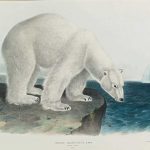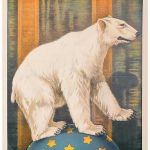Polar Bear Lithographs. Lithography is a method of printing originally based on the immiscibility of oil and water. The printing is from a stone (lithographic limestone) or a metal plate with a smooth surface. It was invented in 1796 by German author and actor Alois Senefelder as a cheap method of publishing theatrical works. Lithography can be used to print text or artwork onto paper or other suitable material.
Lithography originally used an image drawn with oil, fat, or wax onto the surface of a smooth, level lithographic limestone plate. The stone was treated with a mixture of acid and gum arabic, etching the portions of the stone that were not protected by the grease-based image. When the stone was subsequently moistened, these etched areas retained water; an oil-based ink could then be applied and would be repelled by the water, sticking only to the original drawing. The ink would finally be transferred to a blank paper sheet, producing a printed page. This traditional technique is still used in some fine art printmaking applications.
In modern lithography, the image is made of a polymer coating applied to a flexible plastic or metal plate. The image can be printed directly from the plate (the orientation of the image is reversed), or it can be offset, by transferring the image onto a flexible sheet (rubber) for printing and publication.
As a printing technology, lithography is different from intaglio printing (gravure), wherein a plate is either engraved, etched, or stippled to score cavities to contain the printing ink; and woodblock printing or letterpress printing, wherein ink is applied to the raised surfaces of letters or images. Today, most types of high-volume books and magazines, especially when illustrated in colour, are printed with offset lithography, which has become the most common form of printing technology since the 1960s. Reference: Wikipedia
Below are some examples of polar bear lithographs including a John James Audubon and John Woodhouse Audubon print.
Polar Bear, collector card from the Animal Pictures series (D8), issued by the Weber Baking Company to promote Onist Milk and Pullman Bread early 20th century Issued by Weber Baking Company Polar Bear, collector card from the Animal Pictures series (D8), issued by the Weber Baking Company to promote Onist Milk and Pullman Bread. (Album 307, page 20)
Reference: The Metropolitan Museum of Art
John James Audubon and John Woodhouse Audubon (After) POLAR BEAR (PLATE XCI) Hand-colored lithograph, dated 1846, by J. T. Bowen, on wove paper, framed sheet 533 by 680 mm 21 by 26 3/4 in
Sold for 3,750 USD at Sotheby’s in 2014
Plate 2; sheet of satirical vignettes; at centre, ‘Going to the Pole-Booth-ia’, a man in furs confronted by a polar bear. Around the central design: ‘First reading’, a woman instructing a child in its ABC; ‘Home department’, a guard in bearskin; ‘Usher of the black rod’, a demon; ‘Passing a bill’, two shopkeepers scrutinising a bill presented by a dandy; ‘Opponents in the field’, a duel; ‘A representative’, boys with a guy on a stretcher; ‘Proposing an amendment’, the same woman about to beat the child with a bundle of twigs; ‘Foreign affairs’, a man with native American accoutrements but wearing western dress, offering to scalp an officer with a razor; ‘Mastr. Genl. of the Ordnance’, an animated cannon with skeletal limbs and a bomb for a tail; ‘Master of the horse’, a man driving a cart at speed, on which a dead horse is laid. Hand-coloured lithograph
Reference: © The Trustees of the British Museum
Published by: Gabriel Shire Tregear British Date 1834-1840 (c.)
Reference: © The Trustees of the British Museum
Walter L. Main Trained Wild Animal 3 Ring Circus. Milwaukee: Riverside, ca. 1910s. Stock lithograph poster depicting a polar bear on ball. 44 x 30 1/2 “. Toning on edges, else good. Linen backed. A-.
Sold for $3,200 at Potter & Potter Auctions in 2017



